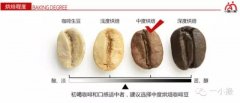The best water temperature for coffee making factors affecting coffee
Coffee needs temperature balance.
Since the coffee machine is equipped with PID temperature control system, there has been a frenzy of temperature control. Professionals say, "We need more accurate temperatures!" and almost all manufacturers have no objection. When we think about these changes and developments, someone may ask, "is the precise temperature control of the machine so important in such a busy bar?"
Common sense of science
Everyone who has studied chemistry knows the concept of heat balance. If you mix two different substances at different temperatures, you will eventually get a substance in between. Coffee is no exception. It is a combination of hot water and cold / hot coffee.
To calculate the heat balance, we need to know the weight, initial temperature and specific heat of each material (the energy absorbed by raising the temperature of 1 g by 1 degree Celsius).
Get data
If we want to brew 40g coffee with 20g coffee powder, we need to mix 65g of water (assuming the retention rate of the liquid is 1.2). The machine may have set a temperature standard of 93 °C (199.5F). The temperature of the coffee it produces is about 20 °C (68F).
The specific heat of water is 4.18j/g/k (Joule / g / Kelvin). Coffee is made of plant materials similar to wood, not completely dry, so I will assume a specific specific heat 1.4j/g/k.
A cup of espresso starts at a lower temperature and finishes at a higher temperature, so remember that what we want to get is the average temperature of the extraction, not the absolute temperature.
So what's the result?
86.2 °C (187F), which may be lower than you think.
What's the big deal for a busy coffee bar?
The key is the temperature of the coffee powder.
The temperature controlled by the coffee machine may be surprisingly consistent, but our coffee powder will not. Grinding produces a lot of friction heat. The absorption of these hot coffee powders changes the above equation.
The bean grinder becomes very hot, and when business is good and the machine is operating frequently, they can easily spit out 50 °C (122F) coffee powder. It is 3.8 °C higher than before.
A simple experiment shows that the temperature of coffee fluctuates by 4 °C, and our machine can be accurate to 0.1 °C. we are happy about this.
Of course, accurate machines are important because they reduce large fluctuations. But you also need to consider the temperature of the coffee powder in order to grasp the overall change. If you can use an infrared thermometer to measure coffee before and after grinding, you will find a startling difference.
But remember, the most important thing in the quality of coffee is consistency. If the coffee powder temperature remains the same (that is, your service level remains relatively consistent), then your coffee temperature can reach a higher level of consistency.

Important Notice :
前街咖啡 FrontStreet Coffee has moved to new addredd:
FrontStreet Coffee Address: 315,Donghua East Road,GuangZhou
Tel:020 38364473
- Prev

Roaster Skills Coffee Knowledge Roasting Coffee Beans
More than a decade ago, the technology of coffee roasting was often secret. Since the employees of roasting factories usually became competitors independently, it was common for inheritance between father and son or relatives. In addition, the purchase cost of large machines was quite expensive, and the threshold for roasting coffee by themselves was too high, making coffee roasting a monopoly of a few large factories.
- Next

How to make Creative Coffee
Every step of bean selection, roasting, mixing, grinding and extraction is the key to affecting the taste of coffee. In the production process, we should be focused, calm, careful, coherent and methodical. A good cup of coffee is more about the barista's understanding of coffee, including the growing environment, planting conditions, picking and processing methods of coffee, etc., which will affect the taste of coffee, even more than a second when brewing coffee.
Related
- Beginners will see the "Coffee pull flower" guide!
- What is the difference between ice blog purified milk and ordinary milk coffee?
- Why is the Philippines the largest producer of crops in Liberia?
- For coffee extraction, should the fine powder be retained?
- How does extracted espresso fill pressed powder? How much strength does it take to press the powder?
- How to make jasmine cold extract coffee? Is the jasmine + latte good?
- Will this little toy really make the coffee taste better? How does Lily Drip affect coffee extraction?
- Will the action of slapping the filter cup also affect coffee extraction?
- What's the difference between powder-to-water ratio and powder-to-liquid ratio?
- What is the Ethiopian local species? What does it have to do with Heirloom native species?

